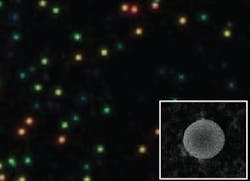| An array of silicon particles of different diameters used in the experiment is seen in a dark-field image. Inset: an image of an individual particle is seen under an electron microscope. (Image courtesy of the authors of the study) |
Scientists from the Moscow Institute of Physics and Technology (MIPT), ITMO University (St. Petersburg, Russia), and the Australian National University (Canberra) have experimentally demonstrated that silicon nanoparticles significantly increase the intensity of the Raman effect, potentially leading to nanoscale light emitters and nanoscale amplifiers for fiber-optic telecommunications.1 In this case, the Raman effect serves to red-shift the wavelength of light.
Until now, waveguides and spherical microcavities, whose size is larger than the emission wavelength, have been used for the Raman-effect enhancement. However, the pursuit for miniaturization of telecommunications devices requires development of smaller optical components.
The group of scientists, including Denis Baranov from MIPT (a postgraduate student of the Problems of Physics and Power Engineering Department) looked for ways of miniaturizing Raman amplifiers.
The researchers used silicon nanospheres that support Mie optical resonances, which exist in any spherical particles with resonant wavelengths that depend on the particle size. One of the resonances that occurs for the largest wavelength is the magnetic dipole resonance, with a wavelength generally comparable to the diameter of the particle. In silicon, however, due to its large refractive index, the magnetic dipole resonance is observed in the optical range (at wavelengths longer than 300 nm) for nanoparticles with a diameter of approximately 100 nm.
This allows smaller silicon nanoparticles to be used as a miniature element to enhance various optical phenomena, including spontaneous light emission, enhanced light absorption, and high harmonic generation.
Different sizes, different resonance wavelengths
The scientists studied the behavior of silicon nanoparticles of different sizes. To determine the size of the particles, they placed them under a microscope and illuminated them with white light. Particles of different diameters demonstrate Mie resonances at different wavelengths resulting in different colors in the dark-field image.
The scientists then tested how the intensity of the Raman emission depends on the diameter of a silicon particle. The intensity of the Raman emission was at a maximum at the resonant diameter of the particle, which was entirely consistent with the theory the authors had developed. The intensity of Raman emission of resonant particles was more than 100 times greater than that of nonresonant particles with other diameters.
"The Raman effect is incredibly useful in practice, and will help not only in detecting microscopic amounts of chemical compounds, but also in transmitting information over long distances," says Denis Baranov, a postgraduate student of MIPT.
Nanolasers
Silicon nanoparticles could serve as a basis for the development of miniature optical amplifiers for fiber-optic networks. In the future, these particles could provide a platform for building a compact nanolaser using stimulated Raman scattering, which offers prospects for very interesting applications in medicine and biomicroscopy. In particular, detecting signals of the Raman emission from particles in the human body will allow specialists to track the movement of drug molecules.
Source: MIPT
REFERENCE:
1. Pavel A. Dmitriev et al., Nanoscale (2016); doi: 10.1039/C5NR07965A
